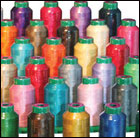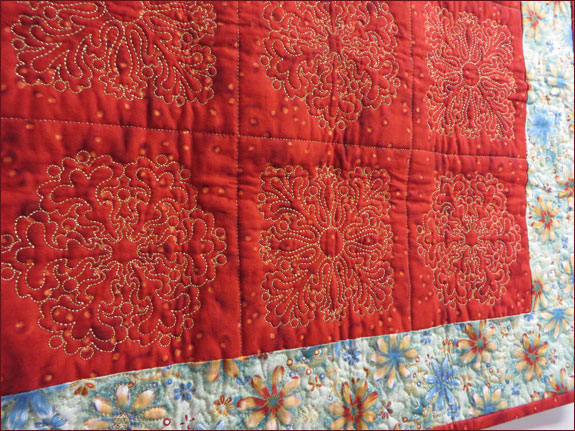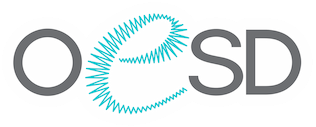Needles and Threads Embroidery Tips
Needles and threads are two very important components for successful embroidery results. To form a stitch, the thread seesaws through the eye of a needle approximately 37 times. That is why it is critical that you use good quality needles and threads. Here are some best practices in the use of needles and threads for your upcoming embroidery projects.
Needles
Needles are important because not all needles are the same. There are several different types and sizes. As with all our sewing projects, the needle choice is determined by the fabric, thread and the technique. For instance, when embroidering on cotton fabric, use an embroidery needle sharp size 80/12.
Needle Sizes
Needles come in an array of sizes. The 80/12 needle is the middle of the size range, and should be used for mid-weight fabrics. The “80” is the European size, and the “12” is the American size. Most of the time, you will see them together, like “80/12”. A 90/14 is a larger needle. The larger the number, the larger the needle. A 70/10 needle is smaller.
If the weight of the fabric is heavy, such as canvas, use a larger size needle, such as a 90/14. Sewing or embroidering on light weight fabric like batiste requires a smaller needle like the 70/10.
Besides the fabric weight, also consider your choice of needle size based on the size of the embroidery design. If embroidering on a linen fabric and using a medium dense design, then use an 80/12 embroidery titanium sharp needle. I also like to use a size 75/11, which is just a little bit smaller and makes a smaller hole in the fabric. If stitching a dense design, then sometimes it is best to use a smaller size needle, so it will slide into the stitches better. Embroidering light to mid-weight t-shirts works best with a 75/11 embroidery titanium ballpoint needle with an applique or a low dense design. Stitching a heavy, dense design on a light to mid-weight fabric will not give successful results. The design is too heavy for the weight of the fabric
Needle Types
 The next consideration is the type of needle. There are many different
types of needles such as quilting, embroidery, metallic, sewing, etc. For our purposes, we are going to discuss embroidery and sewing needles. What is the difference between the two? An embroidery
needle has a larger eye and a specially-shaped scarf, so that the decorative or embroidery threads can seesaw through the eye of the needle and not break or fray. Organ embroidery needles have an
even larger eye which makes them a good choice.
The next consideration is the type of needle. There are many different
types of needles such as quilting, embroidery, metallic, sewing, etc. For our purposes, we are going to discuss embroidery and sewing needles. What is the difference between the two? An embroidery
needle has a larger eye and a specially-shaped scarf, so that the decorative or embroidery threads can seesaw through the eye of the needle and not break or fray. Organ embroidery needles have an
even larger eye which makes them a good choice.
Sewing needles have a regular-size eye and are best for sewing garments and other projects. The eye of the sewing needle is not as large as the embroidery needle. If there are problems with the thread breaking then look at the needle and see what type and also what size. Too small of a needle will also cause the thread to break
Sharp, Ballpoint or Titanium?
The Organ embroidery needles are available in sharps, ballpoint and titanium, and in all different sizes. The sharps are for woven fabrics such as cotton, poly/cotton, linen, towels, satin and batiks. As the name suggests, sharps have a sharp point and will pierce into tightly woven fabric.
The ballpoints are for stretchy fabrics, like knits, jersey, t-shirts, sweaters, sweatshirts, fleece, and anything with spandex or Lycra. Ballpoint needles have a rounded point and push the weave out of the way rather than pierce it. With a stretchy fabric, if a fiber is cut, it can cause a tiny hole to form. Denim and velvet are not in either list, because your choice of a sharp or ballpoint needle depends on whether the denim or velvet has stretch to it.
Titanium needles are available in both embroidery and sewing types and in most sizes. Titanium coated embroidery needles move in and out of the stabilizer, stitches, and fabric better than regular needles. Titanium needles maintain their points longer than regular needles, therefore, lasting 4-5 times longer. They are great to use with specialty stabilizers which have adhesive coatings.
Embroidery needles will need to be changed out more often than sewing needles, as the needle will go through the fabric and layers of stitches and stabilizer many more times. Also, the speed of the embroidery machine is faster than a regular sewing machine. Purchase embroidery needles here...
Threads
 Threads are the other very important component of successful embroidery.
There are many different types of threads. We can actually use most types of threads like regular sewing, cotton, silk and embroidery for embroidery projects. If you have some old wooden spools of thread,
use those for display not sewing! Most of us though want to use embroidery threads because they are shiny and more noticeable.
Threads are the other very important component of successful embroidery.
There are many different types of threads. We can actually use most types of threads like regular sewing, cotton, silk and embroidery for embroidery projects. If you have some old wooden spools of thread,
use those for display not sewing! Most of us though want to use embroidery threads because they are shiny and more noticeable.
There are two types of embroidery threads, rayon and polyester. Both have a beautiful look and are widely available. Rayon thread is a more natural thread and polyester is man-made. Polyester is stronger, more colorfast and more abrasion resistant. If bleach is used on polyester, the colors do not fade or change colors, even after years of use.
Isacord
Isacord, a polyester embroidery thread, is a high-quality embroidery thread. According to Amann USA, “Isacord is a polyester continuous thread that has a comparable shine to a rayon embroidery thread. This is obtained through a special cross-section modified fibre.” Purchase Isacord thread here...
Yenmet
 Another type of thread that is fun to use is Yenmet, a metallic thread.
Yenmet is available in different colors and types not just silver and gold. Yenmet is a metallic thread wrapped with a polyester coating. It is not as wiry as many metallic threads, and is softer.
Yenmet can be used in the needle and the bobbin for freestanding lace designs as well as for quilting in the hoop with outline quilting designs. Be sure to use a good quality embroidery needle when
stitching with the Yenmet like an 80/12 embroidery titanium needle.
Another type of thread that is fun to use is Yenmet, a metallic thread.
Yenmet is available in different colors and types not just silver and gold. Yenmet is a metallic thread wrapped with a polyester coating. It is not as wiry as many metallic threads, and is softer.
Yenmet can be used in the needle and the bobbin for freestanding lace designs as well as for quilting in the hoop with outline quilting designs. Be sure to use a good quality embroidery needle when
stitching with the Yenmet like an 80/12 embroidery titanium needle.
Another tip for using the metallic thread is to slow down the speed of the embroidery machine. It may also be necessary to reduce the needle tension. Stitch out a sample first, before adjusting the tension. Also try placing a thread net over the thread spool, so it stops the thread from sliding and tangling when it is pulled from the spool.
Here is a project that uses the Yenmet metallic thread in the needle and the bobbin for the quilting of the quilt. The two different embroidery designs (BD553_48 & BD554_48) are from the Elegant Line Quilting 5 #12182 embroidery collection.

Yenmet is a beautiful thread to stitch, and the results are fabulous. Give it a try if you haven’t used it before. You can purchase Yenmet thread here...
Thread Nesting
Have you ever been embroidering and ended up with a wad of thread under your hoop? The wad of thread is called “thread nesting” because it looks like a bird’s nest of thread. I often hear this problem before I see it, because the machine will make an awful noise when it happens! Thread nests are almost always a problem with how the machine was threaded. Nesting happens when there is no tension on the upper thread, so it all falls down into the hook area causing a mess. To avoid this problem, make sure that your presser foot is up while threading the machine. With the presser foot up, the tension discs are open for the thread to go down in between them. If threading with the foot down, then the thread doesn’t get placed in the tension discs and there is no tension, causing the nesting. Some newer machines automatically raise the foot up and open the tension discs. Be sure to check your machine’s manual or talk to your dealer to make sure you are threading the machine correctly.
Conclusion
Your choice of needles and threads are important components in having successful embroidery results. Remember, it is vital to stitch out a sample design on the same fabric as possible, using the same type of stabilizer, needle and threads.
This material is © OESD, LLC and may not be reproduced or published without permission.
